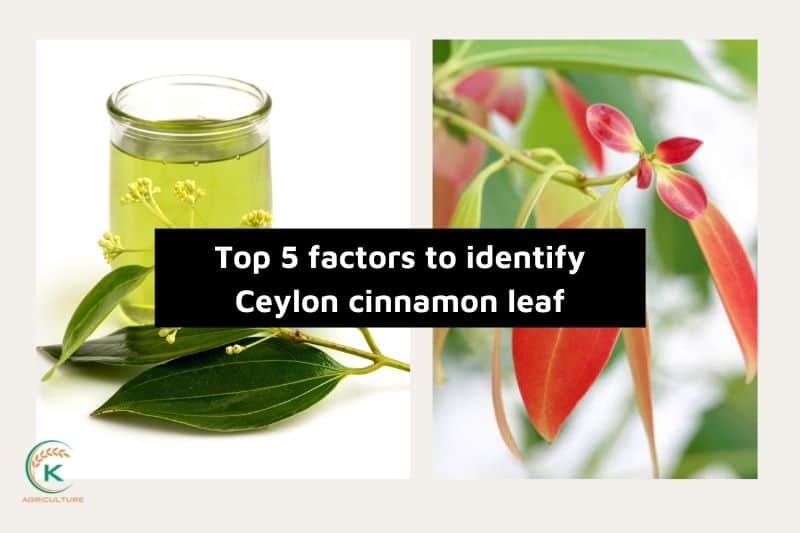For many years, people have utilized the spice cinnamon in their food, medications, and religious rituals. Ceylon cinnamon and cassia cinnamon are the two primary varieties of cinnamon. While both forms of cinnamon have therapeutic benefits and comparable smells, they come from distinct trees and contain varying quantities of the chemical coumarin. This article will concentrate on recognizing real cinnamon leaf, commonly referred to as Ceylon cinnamon leaf.
Contents
- 1 What is Ceylon cinnamon leaf?
- 2 The benefits of Ceylon cinnamon leaf
- 3 How to identify the difference between cassia cinnamon leaves and Ceylon cinnamon leaves
- 4 Tips to buy Ceylon cinnamon leaves
- 5 FAQs
- 5.1 What are the key characteristics of Ceylon cinnamon leaf?
- 5.2 How can I differentiate Ceylon cinnamon leaves from Cassia cinnamon leaves?
- 5.3 What is the difference between Ceylon cinnamon and regular cinnamon?
- 5.4 How do I identify Ceylon cinnamon leaf versus other types of cinnamon?
- 5.5 Can Ceylon cinnamon leaves be used in cooking, and how do they compare to other cinnamon leaves?
- 5.6 Are Ceylon cinnamon leaves safe for consumption?
- 5.7 What are the medicinal uses of Ceylon cinnamon leaves?
What is Ceylon cinnamon leaf?
Ceylon cinnamon leaf or true cinnamon leaf stemmed from Sri Lanka. These huge, exquisitely veined leaves have a pleasant, delicate aroma reminiscent of pure cinnamon. They are seldom found in Western cuisine but are frequently used in Indian and island-inspired recipes. Unlike cinnamon bark, they add a subtle flavor without being overpowering. There are various cinnamon leaves recipes. The leaves are used to flavor steamed food or to stew meals in the sauce for a long period.

What is Ceylon cinnamon leaf?
They are infused to make herbal drinks, ice creams, rum arrangements, and entremets. Cinnamon leaves are also included in several biryani or curry dishes. One of the healthy spices to include in your diet on a regular basis is cinnamon, which has antibacterial and digestive properties.
The benefits of Ceylon cinnamon leaf
Since ancient times, traditional medicine has employed the tasty and aromatic Ceylon cinnamon leaf, which is made from the bark of Cinnamomum verum trees. Ceylon cinnamon leaves are also a great cinnamon product. In addition to its culinary uses, Ceylon cinnamon leaf has a number of possible health advantages. The following are a few of the main advantages of Ceylon cinnamon leaf:
- The Ceylon cinnamon leaf has anti-inflammatory qualities, which may help to lessen the symptoms of diseases including inflammatory bowel disease and arthritis.
- Blood sugar lowering: Ceylon cinnamon leaf has been demonstrated to have a favorable impact on blood sugar levels, which may be beneficial for those who have type 2 diabetes. Additionally, it could increase insulin sensitivity and lessen the chance of developing insulin resistance.
- Improved cognitive performance and protection from brain damage are two benefits of antioxidants found in Ceylon cinnamon leaf. Additionally, it might lessen the likelihood of cognitive deterioration brought on by aging.
- The Ceylon cinnamon leaf may help lower blood pressure and minimize the risk of heart disease, which will improve heart health. Additionally, it could aid with blood flow improvement and cholesterol reduction.
- Fighting infections: The antibacterial, antifungal, and antiviral properties of Ceylon cinnamon leaf can aid in the prevention of infections and strengthen the immune system.
Overall, Ceylon cinnamon leaf is a useful and adaptable spice that is simple to use in a balanced diet. This tasty spice could have a number of possible health advantages, whether you sprinkle it over your porridge in the morning or use it in a hearty curry dinner.
How to identify the difference between cassia cinnamon leaves and Ceylon cinnamon leaves
There are some factors that help distinguish cassia cinnamon leaves and Ceylon cinnamon leaves. Let’s discover!

factors to identify Ceylon cinnamon leaf
Consider the color
Comparatively speaking, a cassia cinnamon leaf is darker than a Ceylon cinnamon leaf. Ceylon cinnamon leaves often have a light green or yellowish-brown tint, but cassia cinnamon leaves have a deeper brown or reddish-brown color. The different trees that they are gathered from are the cause of the color variation. While cassia cinnamon originates from the Cinnamomum cassia tree, true cinnamon is derived from the Cinnamomum verum tree.

Consider the color
Check the texture
In contrast to the cassia cinnamon leaf, which is thicker and more durable, true cinnamon leaf has a thin, paper-like feel and is more sensitive. According to experts from K-Agriculture, a pure cinnamon leaf will crumble readily when you rub it between your fingers, but a cassia cinnamon leaf will feel more tough and leathery.
Inhale the Aroma
In contrast to cassia cinnamon leaf, which has a powerful, spicy, and pungent scent, true cinnamon leaf has a pleasant, warm, and delicate perfume. The chemical compound cinnamaldehyde, which also gives authentic cinnamon its distinctive fragrance, is also what gives it its medicinal benefits.
Sample the flavor
Contrary to the cassia cinnamon leaf, which has a strong, spicy, and bitter flavor, the true cinnamon leaf has a sweet, mild, and somewhat lemony flavor that is less potent. Eugenol, a substance also present in cloves, gives the authentic cinnamon leaf its distinctive taste.

Sample the flavor
Verify the Source
While cassia cinnamon leaf is found in China, Vietnam, and Indonesia, the true cinnamon leaf is mostly grown in Sri Lanka, India, and Madagascar. Look for items that are marked as Ceylon cinnamon or Sri Lankan cinnamon if you want to make sure you are purchasing real cinnamon leaf.
See Detail At: Cassia Vs Ceylon Cinnamon. 5 “True” Spice Factors For True Life
Tips to buy Ceylon cinnamon leaves
If you are wondering about how to buy cinnamon leaves, we will provide some tips to assist you choose the best Ceylon cinnamon leaves.
Search for quality indicators
Quills, which are rolled-up pieces of bark with a unique curl, are sometimes used to package and sell true cinnamon leaf. Look for nicely curled, thin, and color-coordinated quills. Additionally, you should look for oil droplets, which are a sign of high-quality, fresh cinnamon.
Purchase from a Reliable Source
It’s crucial to purchase from a reputable vendor that specializes in genuine and premium cinnamon items if you want to make sure you’re getting real cinnamon leaves. Look for companies who have a history of obtaining their cinnamon from reliable growers and applying environmentally friendly agricultural techniques.

Purchase from a Reliable Source
FAQs
What are the key characteristics of Ceylon cinnamon leaf?
Ceylon cinnamon leaf, also known as Cinnamomum verum, is typically smaller and has a smoother texture compared to other cinnamon varieties. It features a distinct aromatic scent, often considered more delicate and sweet compared to Cassia cinnamon leaves.
How can I differentiate Ceylon cinnamon leaves from Cassia cinnamon leaves?
The most noticeable difference between Ceylon cinnamon leaves and Cassia cinnamon leaves is in their veins. Ceylon cinnamon leaves have fine, narrow veins, while Cassia leaves are thicker and have more prominent veins. Ceylon cinnamon also tends to be lighter in color, with a greenish hue, unlike Cassia, which has darker and thicker leaves.
What is the difference between Ceylon cinnamon and regular cinnamon?
Ceylon cinnamon (Cinnamomum verum) is considered “true cinnamon,” while most cinnamon found in stores is Cassia cinnamon (Cinnamomum cassia). Ceylon cinnamon has a finer, softer texture, while Cassia is harder and thicker. Ceylon cinnamon is also known for its sweeter, more complex flavor, whereas Cassia cinnamon has a stronger, spicier taste.
How do I identify Ceylon cinnamon leaf versus other types of cinnamon?
Ceylon cinnamon leaves are thinner, softer, and less rigid than other types, such as Cassia. They also have a smoother surface and are aromatic without being overpowering. In comparison, Cassia cinnamon leaves are rougher, thicker, and have a sharper scent.
Can Ceylon cinnamon leaves be used in cooking, and how do they compare to other cinnamon leaves?
Yes, Ceylon cinnamon leaves are commonly used in cooking for their sweet and delicate flavor. Compared to other cinnamon leaves, such as Cassia, Ceylon cinnamon leaves provide a more subtle and refined taste. They are often preferred in dishes requiring a gentle cinnamon flavor, such as desserts and beverages.
Are Ceylon cinnamon leaves safe for consumption?
Yes, Ceylon cinnamon leaves are safe for consumption. They contain lower levels of coumarin, a compound found in Cassia cinnamon, which can be harmful in large quantities. Therefore, Ceylon cinnamon is considered the safer option for regular use in food and beverages.
What are the medicinal uses of Ceylon cinnamon leaves?
Ceylon cinnamon leaves have anti-inflammatory, antioxidant, and antimicrobial properties. They are often used in traditional medicine to help with digestive issues, regulate blood sugar, and enhance immune function. The leaves also have a calming effect and may aid in reducing stress.
In conclusion, the Ceylon cinnamon leaf may be recognized by its color, texture, scent, flavor, origin, and quality indicators, as well as by purchasing it from a reputable vendor. You can make sure you are receiving the real deal and taking advantage of all the medicinal benefits that genuine cinnamon leaf has to offer by following these instructions.





Please Post Your Comments & Reviews